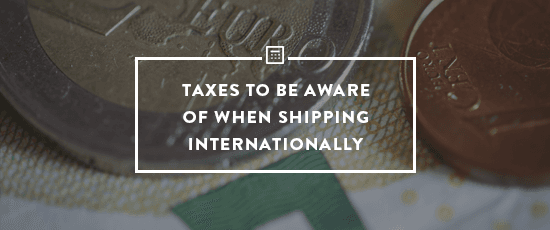Ecommerce
Taxes to be Aware of When Shipping Internationally
- Written by Jodie Pride

Offering international shipping can be great for ecommerce retailers because it exposes you to a much wider market, but retailers need to make themselves aware of the taxes involved in shipping overseas. We’re going to look the taxes involved when shipping goods to the UK, Australia, Japan and China.
Retailers shipping to the UK
Goods imported to the UK from outside the EU require you to pay import duty and VAT, and make a declaration to customs. In general, import duty is a tax that the importer has to pay to bring foreign goods into his or her country. Import VAT (Value Added Tax) is a tax charged on imported goods and services. Duty and VAT are calculated as a percentage of the value of the imported goods, consisting of the product value and the freight & insurance costs. For importing into the UK, duty and VAT are normally due when a minimum value threshold of £15 is reached. Duty is not paid on consignments shipped within the EU. Import duty rates vary depending on the type of goods; many goods are duty free. Relief from duty and VAT may apply in special cases. Also, in some cases additional duties may be charged, depending of the country of manufacture of the goods. Imports from outside the EU into the UK must be declared to HMRC. This is usually done using the Single Administrative Document (SAD), also known as form C88. SADs can be submitted either electronically using the Customs Handling of Import and Export Freight (CHIEF) system, or manually (although manual submissions may take longer to process)
Retailers shipping to Australia
All imported goods including mail articles are assessed for community protection risks, permit and approval requirements. Examples of imported goods which may pose a risk to the community include:
- gas and electrical goods that do not meet Australian safety and technical standards, or
- children's toys or playthings with a coating that contains excess amounts of toxic compounds such as lead, arsenic and barium.
All imported goods (whether for commercial purposes or for personal use) are also assessed for duty and Goods and Services Tax (GST) and other taxes and charges that may be applicable. Whether you are a private individual or a commercial entity, you must pay import duty and taxes when importing goods to Australia. The valuation of the cost is based on the complete shipping value, including:
- the price of the imported goods
- the cost of freight
- insurance
The imports are also subject to sales taxes. If the import’s value is under 1000 AUD, no tax and duties apply. GST is a tax levied by the Australian Taxation Office (ATO). The ATO states that the “goods and services tax (GST) is a broad-based tax of 10% on most goods, services and other items sold or consumed in Australia.” GST, currently 10%, is calculated on the Customs Value of the goods, plus duty, plus transport and insurance combined. Wine Equalisation Tax (WET) may also be applicable if the imported goods are wine. Duty Payable Duty rates payable are determined by the tariff classification for your goods. The Customs Tariff Act 1995 (known as The Tariff) provides the tariff classifications, duty rates, interpretive rules and information on preference schemes, other concessions and exemptions that may apply to your goods. The Tariff is available at Customs and Border Protection counters or on the Customs and Border Protection website. Duty is payable on the Customs value of the goods. GST Payable GST applies to most imported goods, with a few exemptions. The main exemptions are for certain foodstuffs, some medical aids and imports that qualify for certain duty concessions. GST is applied at 10% of the value of the taxable importation (VoTI). Additional information is available from the Australian Taxation Office, Customs and Border Protection counters or on the Customs and Border Protection website. For imported goods the value of the taxable importation (VoTI) is the sum of:
- the customs value (CV)
- any duty payable
- the amount paid or payable to transport the goods to Australia and to insure the goods for that transport (T&I), and
- any Wine Equalisation Tax (WET) (a tax applicable to alcoholic beverages) payable.
Retailers shipping to Japan
When importing commercial or private goods into Japan import duty and taxes are due to be paid. These are valued by cost, insurance and freight (CIF), meaning that import dury and tax payable is calculated on complete shipping value, including the cost of imported goods, cost of freight and the cost of insurance. The duty rates when importing to Japan can vary from 0% to 30%, with the average being 4.49%, although some take into consideration different measures as well as CIF. Some products qualify for free import duty (including books and some electrical products such as laptops). Consumption tax is levied on imports at a standard rate of 8% calculated on the sum of the CIF value and duty. Excise duty is applicable on alcohol, tobacco and fuel products. For imports into Japan, there are minimum thresholds below which duty and Consumption Tax are waived. Duty will not be charged if:
- the CIF value, i.e. the sum of the value of the goods, shipping and insurance cost, does not exceed JPY10,000
- the amount of duty payable does not exceed JPY100
Consumption Tax will not be charged if:
- the CIF value, i.e. the sum of the value of the goods, shipping and insurance cost, does not exceed JPY10,000
- the amount of consumption tax payable does not exceed JPY100
Retailers shipping to China
If you’re importing to China, there are 3 types of tax you need to be aware of:
- Value-added tax
- Consumption tax
- Customs duties
We’re going to explain each one: Value-added Tax for Imported Goods If you import goods to China, they are subject to value-added tax (VAT). The tax rates are the same as those applied to goods sold within the domestic market (i.e. 17 percent, and 13 percent for some goods). You can pay VAT on the day of customs clearance, and the input VAT imposed on importing goods can be used to deduct the output VAT paid when the imported goods are sold in the domestic market. Consumption Tax for Imported Goods There are certain items which are subject to consumption tax (CT). These include luxury products such as high-end watches and jewellery, non-renewable petroleum products, and high-energy consumption products such as cars. Customs Duties Customs duties include import duties and export duties. Customs duties are computed either on an ad valorem basis or quantity basis. Import Duties Duty rates on import are made up of the following: Most-favored-nation duty (MFN) rates These are the most common import duty rates. They are a lot lower than the general rates which apply to non-MFN nations. They apply to the following goods:
- Goods imported to China from WTO member countries;
- Goods originating from countries or territories which have concluded bilateral trade agreements containing provisions on MFN treatment with China; and
- Goods that originated from China.
Conventional duty rates These are applied to imported goods that originate from countries or territories that have entered into regional trade agreements containing preferential provisions on duty rates with China. Under the 2013 Tariff Plan:
- 1,875 imported goods originating from South Korea, India, Sri Lanka, Bangladesh and Lao adopt the Asia-Pacific Trade Agreement conventional duty rates.
- Certain commodities from members of the Association of Southeast Asian Nations (ASEAN), Chile, Pakistan, New Zealand, Singapore, Peru and Costa Rica are subject to conventional duty rates under the relevant free trade agreements.
- Some imports from Hong Kong, Macau and Taiwan are allowed tariff-free policies.
Special preferential duty rates Special preferential duty rates are applied to imported goods originating from countries or territories with trade agreements containing special preferential duty provisions with China. They are generally lower than MFN rates and conventional duty rates. Under the 2013 Tariff Plan, special preferential duty rates are applied to certain goods originating from 40 Least Developed Countries as classified by the United Nations. These countries include Ethiopia, Rwanda and Afghanistan. Temporary duty rates Occasionally, China sets temporary duty rates for certain imported goods. To boost imports and meet domestic demand in 2013, China implemented temporary tax rates lower than the MFN tariff on more than 780 imported commodities, including seasoning products, pacemakers, special-formula infant milk powder, and resources including kaolin, alfalfa and eiderdown. Place of Origin You want to make sure that the tariff rate you apply is the correct one. In order to do this, you need to identify which country your goods originate from. China’s place of origin regulations dictate that if goods sourced entirely from one country, then that country is the place of origin. If goods are produced in more than one country, the country in which the goods undergo final substantial final changes/completion is the place of origin. Duty Paying Value for Imported Goods The amount of import taxes and customs duty payable is calculated based on the price or value of the imported goods. This value is called the duty paying value (DPV). DPV is determined based on the transacted price of the goods – i.e. the actual price directly and indirectly paid or payable by the domestic buyer to the foreign seller, with certain required adjustments. DPV includes transportation-related expenses and insurance premiums on the goods prior to unloading at the place of arrival in China. Import duties and taxes collected by Customs are excluded from DPV. You should always be careful when offering international delivery and these are just some examples of the complicated charges involved with overseas shipping. Make sure you educate yourself on the taxes and other charges involved before you offer international shipping, and be sure to keep up to date with any changes in policies. Selling online? Try Veeqo, a Xero add on and one stop to manage orders, products, inventory, shipping for merchants who sell on marketplaces such as ebay, Amazon, shopify, woocommerce. You can also manage your Xero inventory.






